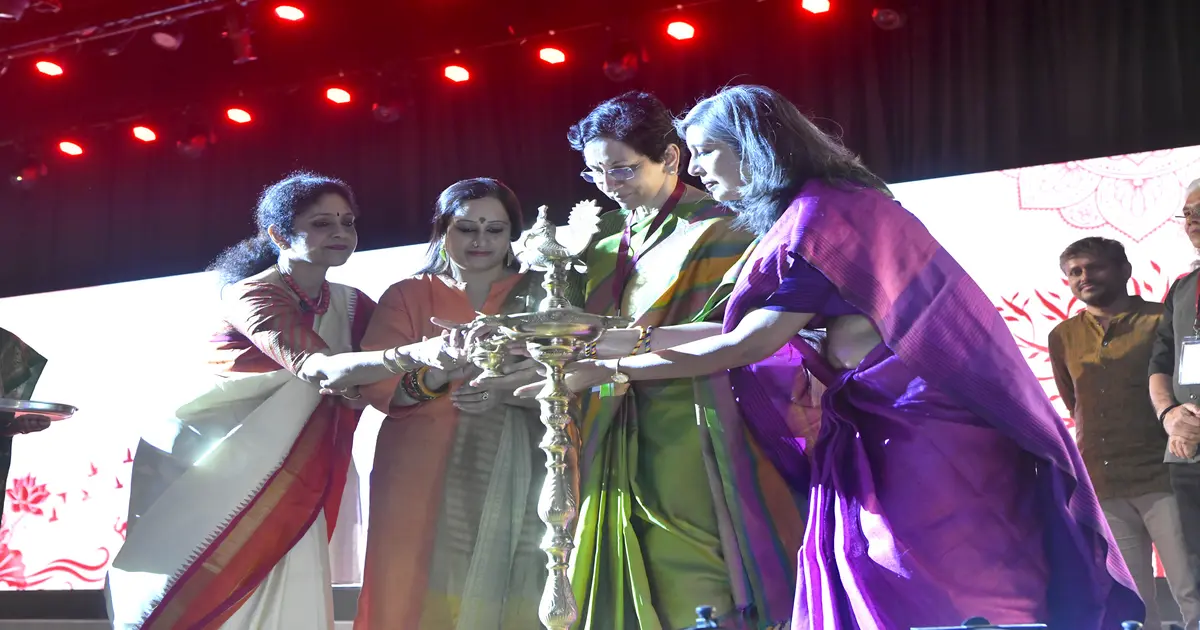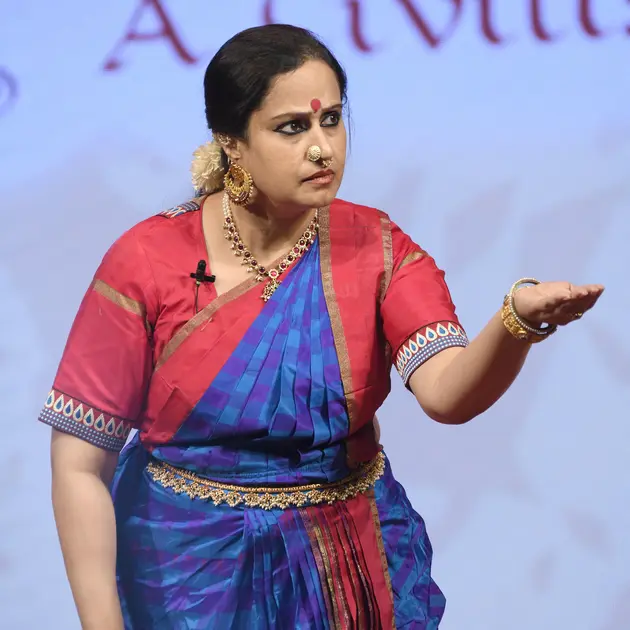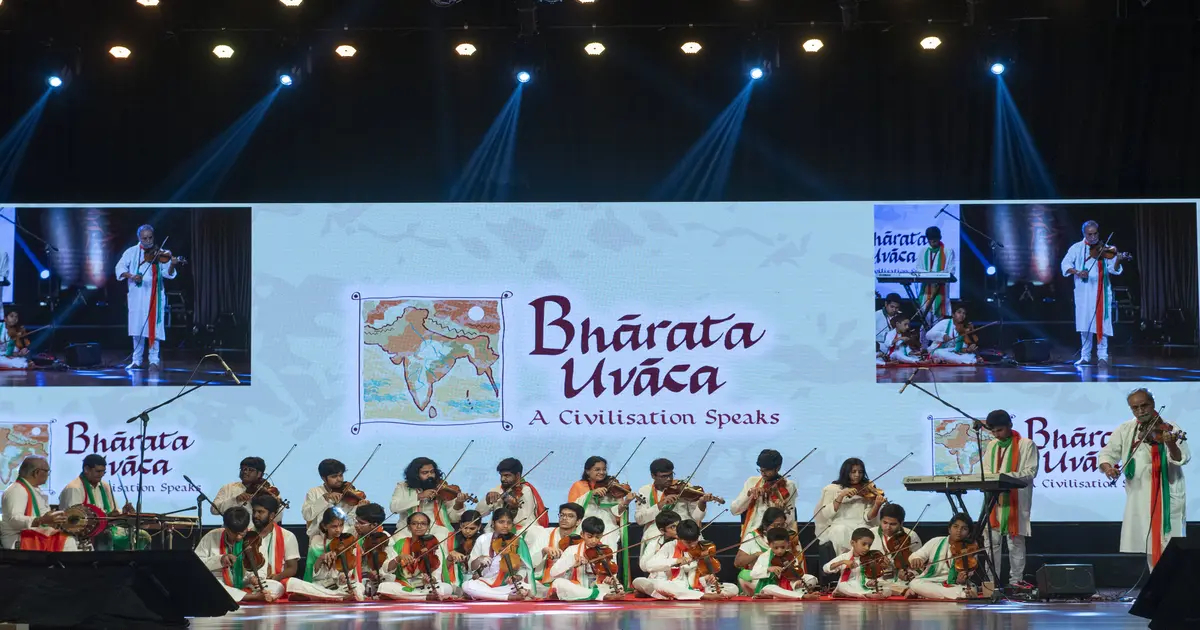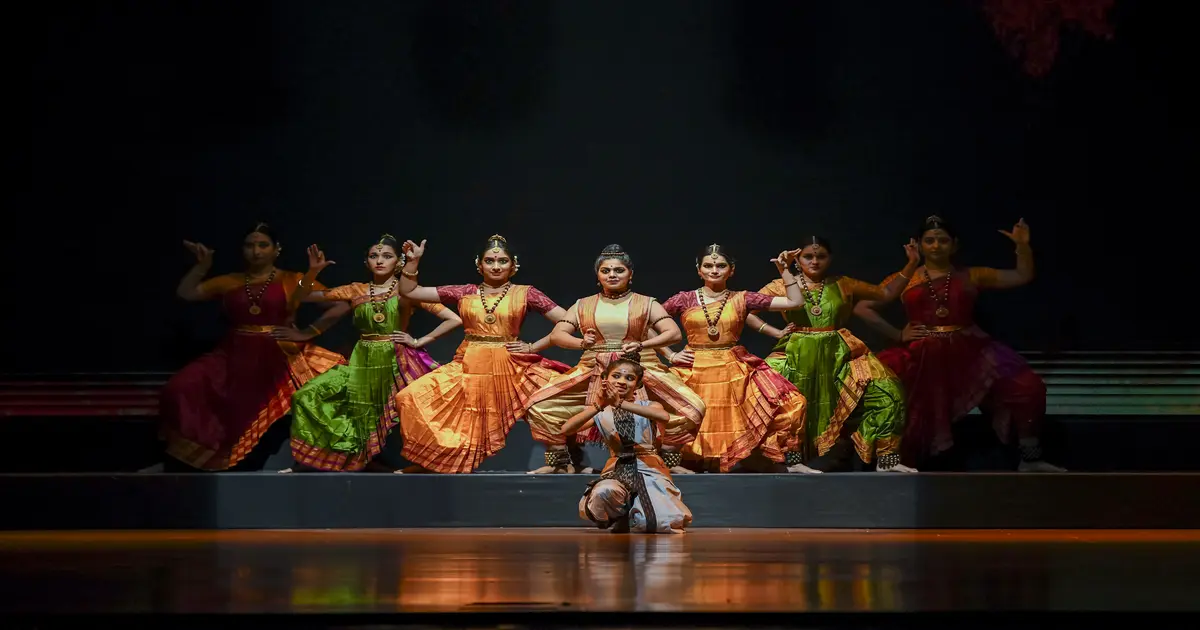The What and Why of Bhārata Uvāca
Bhārata Uvāca: A Cultural Movement in Bhagyanagar, fostering a distinct and inclusive space for art, education, and tradition, aiming to bridge generational gaps and preserve India's rich heritage in a world of evolving entertainment.

Share this Page
Chennai has its music festival, Bengaluru has its literary festival, Mumbai has the film industry, Kolkata has its theatre, Bhubaneswar has its temples, Mysuru has Dussehra, Pune has Shivaji Maharaj, and Delhi has it all. For Hyderabad, which was once a lazy Nizami town until the early 90s, it does seem to lack a certain distinct-ness. Yes outsiders love it here because they do not feel othered, yes locals are affectionate and welcoming, yet there is no specific vibe to it. As of today, it is just another wannabe city with restaurants galore, teeming with flyovers and traffic. Even its fan-crazed cinema culture, with RTC X roads as its HQ, has diminished with the advent of the multiplexes.
Where can you dress up and go in Hyderabad, if you are eighty and also eighteen? Pubs and Tabula Rasa like places bar anyone in ‘Indian ethnic wear’ or at least the peer pressure does, such places are age-ist and attire-ist. Dhotis, saris and bindis are not welcome, let alone senior people. At kutcheris and spaces such as Saptaparni, which are associated with ‘high culture’, we do not see the hip and happening youth, at La Makaan you better be a rebel or have issues with society, so where is THE space where a family need not separate itself for entertainment, which is not divisive by age or attire, where one can spend a lovely evening participating in what our civilization has to offer?
What could Bhāgyanagaram’s cultural draw be? As Padma Śrī Dr. Ananda Shankar Jayant has proved time and again, with her performances, her ballet productions, her Dance App and her more recent venture Kutty Kahani, “as India marches onward from Her 75 years, it is time to encapsulate the centuries old wisdom and knowledge that the civilization Bhārata has bequeathed to us”, this visionary idea by her rang true with us at Bṛhat. We too have been thinking on these lines ever since we were born, a year ago, and what better collaborator and cultural ambassador than Ananda ji to bring this dream to fruition.
On a lovely monsoon evening, the weather inviting, with leisure at hand, where would a Hyderabadi go for artistic and cultural fulfilment? Where is the kathākālakṣepam of yore? Where is sahasrāvadhānam or śatāvadhānam being feted? Where are the kavi saṃmelanams? Or the veda goṣṭhis? They happen for sure but in small pockets, in rare chambers and for a rarer audience. How then is our youth to know of their heritage? If we do not apprise them with their civilizational pūnjī who will? We grappled with such questions and came up with Bhārata Uvāca.
Many of our cities and towns have nothing to offer to its residents. There is OTT and Swiggy in everyone’s life but not what ought to be our birthright. Films, TV series, Fast Food and Fast Cars are not the only means of entertainment, in fact they are not wholesome at all. Asuras in our texts are defined as asuṣu ramante, those who revel in sense pleasures. If we pride ourselves in being more than asuras, we must raise our standards too. We must refine our senses to appreciate our sānskṛtika rasa, and not be pleased with instant gratification.
We must demand access to our bhāratīya jñāna paramparā, our saṅgīta and nṛtya, our way of looking at the world, our aesthetics, our point of view or dṛṣṭikoṇa. We must work towards platforming a space where our numerous achievements can be showcased, where the young and old can mingle and take satisfaction in the legacy bequeathed to them by their ancestors.
Bhārata Uvāca is not yet another TedX Talk or another Spic Macay programme. It is both these and much more. As Founder-CEO, Bṛhat, Raghava Krishna aptly puts it, “Bhārata Uvāca is the birthing of a Cultural Brand with a Civilizational Consciousness, as also the creative ecosystem which upholds it”. It is not here to present and showcase something for an hour or a day. It is a promise of continual engagement both at the local and national level on a regular basis. Building the base, providing the space, and transforming the cultural scene of today’s India.
On Aug 5th 2023 at the Shilpakala Vedika the first full day event started with the auspicious vedic chants by the veda paṇḍitas of Veda Bhavan Secunderabad. These included mantras from the Rājasūya Yajña. For a full ten minutes there was pin drop silence in the jam packed auditorium that seats about two thousand people. A surprise message from Sadhguru wishing us success made our day, this was a video telecast. Following the lighting of the lamp, the talks started with J. Sai Deepak ending with Anand Narasimhan. Each invitee spoke for about twenty minutes giving their take on their chosen field, highlighting one aspect of artha, kāma, dharma or mokṣa. Monika Halan, Gautam Chikermane, Muneet Dhiman, Shantanu Gupta, Shefali Vaidya, Anurag Saxena, Kalpana Ramesh, Prshant Lahoti, and Chitra Madhavan, all spoke eloquently and with passion. Their talks are available here.
A few teasers here on what was spoken about to entice the readers to watch the complete talks. Speaking of some of the challenges that Bhārat faces today, Śrī J. Sai Deepak, Supreme Court lawyer, warned us that our religious places are not meant for religious tourism. We must encourage punarnirmāṇa not navanirmāṇa. Śrī Shantanu Gupta of the Ramayana School conducted an interactive quiz with the audience on How to Kill the Rāvaṇa within. He encouraged the audience to read at least ten ślokas from Vālmīki Rāmāyaṇa daily, raising the Rāma in us. Smt. Chitra Madhavan stressed on the need for making a concerted effort to put back the Hindu temple where it belongs, fair square and centre in people’s daily lives, with its numerous architectural, social, religious, spiritual, educational, cultural, environmental and economic contributions. Śrī Gautam Chikermane emphasised how the rājasika force of India is rising again. This fresh burst of energy may be noticed in governance, politics, geopolitics, international relations, economy as well as culture and cinema. He credited Śrī Aurobindo for applying the theory of guṇas to nations. Smt. Monika Halan urged us not to think of money as bad, and that we must move from a poverty mindset to an abundance mindset. The pursuit of money is something the ancients also blessed us with, they understood that artha is what drives dharma. Anurag Saxena of the India Pride Project goaded the audience to create pressure groups, have public consultations, and converse with the policymakers, to help get our stolen archaeological artefacts back from abroad.
Śrī Prshant Lahoti, Co-Founder of Kalakriti Art Gallery, and a map collector extolled the use of pilgrimage maps for yātra. These special maps depict the significance of each spiritual site, and are based on oral traditions. The main use of these maps is liberation through darśana for those who are unable to physically take up an arduous journey due to old age or health issues. Śrī Muneet Dhiman, founder Vidyakshetra, explained the state of education in our country today, where the breaking of traditional learning centres have left us ill equipped to deal with the world. Vidyakshetra employs the pañcakośa model where icchā śakti, jñāna śakti, and kriyā śakti find expression in its curriculum via twenty four different subjects. Smt. Shefali Vaidya praising the extensive weaving traditions of our land, where every district has its own warp and weft, reminded us how there was lot of respect for weavers during the reign of Hindu kings, and that we must bring that lost respect back via buying handlooms (directly from the weavers) and wearing handlooms as much a possible. Hyderabad’s very own Smt. Kalpana Ramesh speaking on the Reawakening of the Water Cakra, showed a video of the Bansilal Step Well development project in Secunderabad. Respect water, and make rainwater harvesting a duty not a choice, she reiterated. Śrī Anand Narasimhan, senior anchor at CNN-News 18, had a to-do list for the youth, for them to appreciate the Integral Concept of Nationhood; First off, stop this self loathing and write down five unique things about this civilization, then; a. Disembark on an unplanned railway station and ask the locals for a glass of water, spend a few days there b. Every once in a week, make a post about Bharāt with the hashtag #Bharat (not about yourself). We look forward to the young in the audience to take up such challenges with an adventurous and patriotic spirit!
The three performative pieces were breathtaking, each taking us a notch higher in experiencing artistic bliss. Dr. Anupama Kylash’s pre-lunch lecture demonstration specifically on Sarangapani’s nindā stuti, followed by her consummate abhinaya brought in great appreciation. As did the post-lunch violin ensemble Aarabhi from the by-lanes of Chikkadpally, lead by maestro Śrī Ashok Gurjale. The little kids, some of them shorter than the violins they were playing on, drew a lot of accolades for their excellent musical offering.


The showstopper without doubt came at the end of the evening; Shankarananda Kalakshetra’s Tales from the Bull and the Tiger. Ananda ji, in this choreography showcases the inherent divinity in nature. To speak of our devatās via their vāhanas was a delightful surprise. Mice, peacocks, bulls and tigers were easily recognizable through their unique antics. Her imagery of Pārvatī as a householder dealing with four pets and two boys, scurrying about in the kitchen, with mūśika jumping out of a rice dabba and running away, leaving a trail of fallen utensils, brings the goddess closer to us. In innovating within tradition Ananda ji shows us how one can tweak maryāda to suit the current times without crossing it. Children naturally want to know how their parents met, and this is reflected here, where the Bull and the Tiger speak of how Śiva and Pārvatī met and married. Such a depiction helps the next generation connect better with these ancient stories. Mithun Shyam’s śiva tānḍava was the highlight of the evening, who lived in his role of Mahādeva. From his body language, his mudras to the last toe, and his abhinaya, finding expression via Śrī Dayananda Saraswati’s Bho Shambho and the fast paced percussion filled śiva tānḍava stotram, he oozed śiva tattva through and through. All the dancers did a spectacular job in dancing with precision and exactness within clean body movements. The music, lighting, costumes, animation in the background, every aspect was conducive to the overall choreography. Neha Sattanapalle stood out as Pārvatī, a very apt choice. The last scene of a sleeping, yawning, cozy family reminded us all of our own families that we return to at the end of each day. It reminded us of the value of gṛhastha āśrama and how it yokes dharma in society with the stability it provides for individual blossoming.

Of course there was chai, kāpi and tiffin, and when organizing anything in Hyderabad, bhojanam is a must. No one here steps out without being assured of the same, and why not? We are a civilization which has the longest surviving culinary history in the world, and so extensive too, with numerous texts and tomes on pākaśāstra. Food is culture. Simply South was simply delicious in the menu it spread for us from the pakodas to the mirchi bajjis to the delectable fare for lunch and dinner, just like a home cooked meal. A rarity these days.
It is a week since and we are inundated with texts, tweets, letters and calls from young and old alike asking for more and sending us gifts and mementos, stating how touched and transformed they are by what they saw and heard last Saturday. We are only nimitta in this larger plan by īśvara, we can only do His bidding. With the generous support of the Ministry of Culture, with partners Shankarananda Kalakehstra, Natyarambha, Bṛhat, and SAHE, Bhārata Uvāca, at the critical intersection of Culture, Art and Education, a sold out success story in its very first offering, is ready for the national stage. Starting with the holy ghats of Kashi, Ayodhya, to the misty mountains of Dharamshala, Patnitop, to the stark deserts of Thar, Kutch, by the ocean beaches in Thiruvananthapuram and Kanyakumari, completing the circuit in the verdant hills of Shillong, Aizawl.
Our idea behind it is that it ought to be a transformative experience, guiding each of you on a path of your own, for your own personal exploration. We do not want it to be just another event to pass time but that it be a respectful use of everyone’s time for furthering a higher cause. Where aesthetics meets philosophy and the performances and talks are relevant to each one of you in Bhārata Deśa. This is our contribution to the #AzadiKaAmritMahotsav.
Jai Hind!
या सर्वासु दिशासु कीर्तितगुणा
श्रेष्ठा च या भूमिषु
विद्यासंस्कृतिरक्षणे च गुरवः
शिष्या रता सर्वदा।
यत्रत्याश्च जनाः सतां पथि
गता धर्मार्थकामप्रदे
एवं च रक्षणरतो हि परम्परायाः
सर्वं हि भारत उवाच जगद्धिताय॥
Her fame spread across all lands and universes
by Prof. Gauri Mahulikar
foremost among all - extolled for virtue and glory
where - devoted to preserving culture and knowledge -
the guru and śiṣya carry forth the flag of dharma
where people stick to the path of good shown by the noble
which leads to dharma artha and kāma
protecting the unbroken paths of traditions
She speaks - the wisdom of an Ancient Civilisation!
Bhārata Uvāca!
Vande Mātaram!